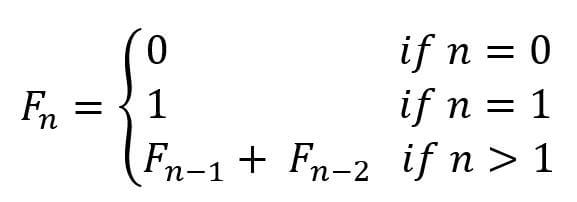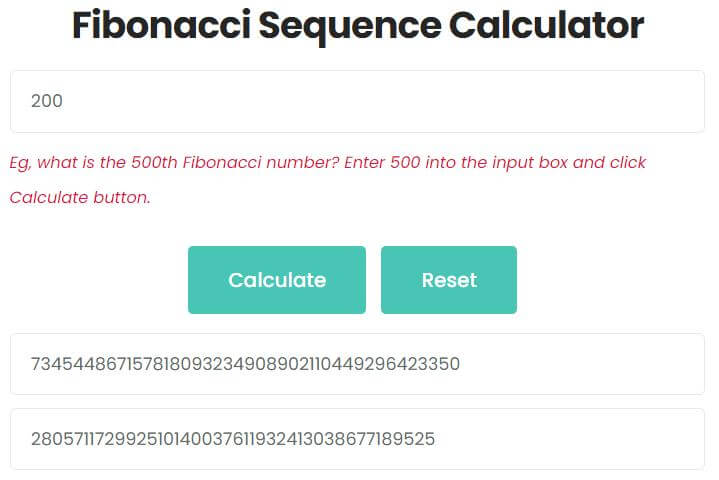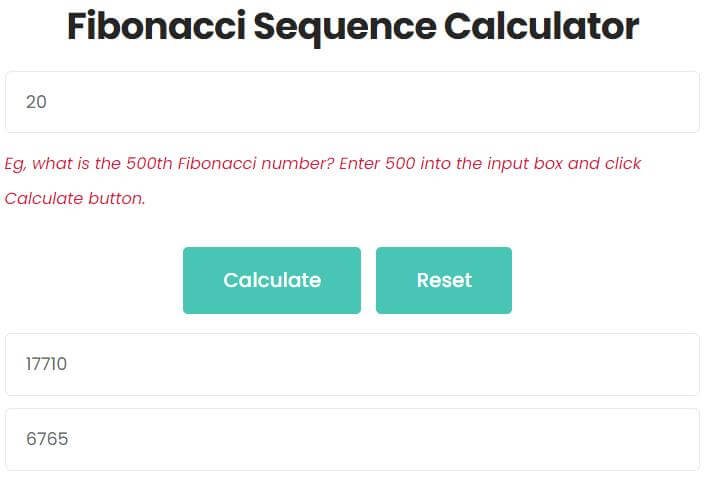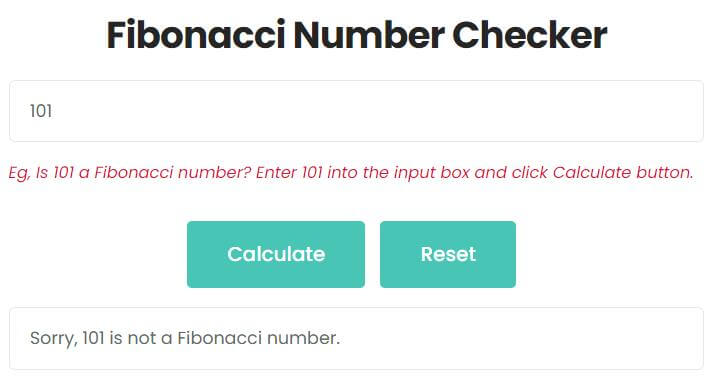Welcome to the Fibonacci Sequence Calculator. Here, you can easily solve 3 problems:
- The sum of the Fibonacci sequence.
- The Nth term of the Fibonacci sequence.
- Checking if a number is a Fibonacci number.
What is the Fibonacci sequence?
Similar to Lucas numbers, the Fibonacci sequence has a recursive relationship where each term in the series is the sum of the previous two terms. The first two terms of the Fibonacci sequence are 0 and 1, while the first two in the Lucas numbers are 1 and 2. Usually, Fn is used to represent the Fibonacci numbers.
The formula for Fibonacci numbers is as follows:
 For example, the 5th Fibonacci number.
For example, the 5th Fibonacci number.
F5 = F4 + F3
F4 = F3 + F2
F3 = F2 + F1
F2 = F1 + F0
F5 = F4 + F3 = F3 + F2 + F3 = 2 * F3 + F2 = 2 * (F2 + F1) + F2 = 3 * F2 + 2 * F1 = 3 * (F1 + F0) + 2 * F1 = 5 * F1 + 3 * F0 = 5 * 1 + 3 * 0 = 5
So, the 5th Fibonacci number is 5.
First 100 Fibonacci numbers
- 0
- 1
- 1
- 2
- 3
- 5
- 8
- 13
- 21
- 34
- 55
- 89
- 144
- 233
- 377
- 610
- 987
- 1597
- 2584
- 4181
- 6765
- 10946
- 17711
- 28657
- 46368
- 75025
- 121393
- 196418
- 317811
- 514229
- 832040
- 1346269
- 2178309
- 3524578
- 5702887
- 9227465
- 14930352
- 24157817
- 39088169
- 63245986
- 102334155
- 165580141
- 267914296
- 433494437
- 701408733
- 1134903170
- 1836311903
- 2971215073
- 4807526976
- 7778742049
- 12586269025
- 20365011074
- 32951280099
- 53316291173
- 86267571272
- 139583862445
- 225851433717
- 365435296162
- 591286729879
- 956722026041
- 1548008755920
- 2504730781961
- 4052739537881
- 6557470319842
- 10610209857723
- 17167680177565
- 27777890035288
- 44945570212853
- 72723460248141
- 117669030460994
- 190392490709135
- 308061521170129
- 498454011879264
- 806515533049393
- 1304969544928657
- 2111485077978050
- 3416454622906707
- 5527939700884757
- 8944394323791464
- 14472334024676221
- 23416728348467685
- 37889062373143906
- 61305790721611591
- 99194853094755497
- 160500643816367088
- 259695496911122585
- 420196140727489673
- 679891637638612258
- 1100087778366101931
- 1779979416004714189
- 2880067194370816120
- 4660046610375530309
- 7540113804746346429
- 12200160415121876738
- 19740274219868223167
- 31940434634990099905
- 51680708854858323072
- 83621143489848422977
- 135301852344706746049
- 218922995834555169026
How to use the Fibonacci sequence calculator
The calculator consists of two parts, one to calculate the sum and Nth term of the Fibonacci sequence, and the other to is used to check if a given number is a Fibonacci number.
The sum and Nth term of the Fibonacci sequence calculator
- Enter the positive integer in the first input box (Number less than 2000).
- Click Calculate button to calculate the sum and Nth term of the Fibonacci sequence.
- Click the Reset button to start a new calculation.
Fibonacci Number checker
- Enter the positive number in the first input box.
- Click Calculate button to verify whether the input number is a Fibonacci number.
- Click the Reset button to start a new verification.
Solved examples using the Fibonacci sequence calculator
Example 1: What is the 200th Fibonacci number?
In an Fibonacci sequence calculator, enter 200 into the input box and click Calculate button, as shown in the figure, the 200th Fibonacci number is 280571172992510140037611932413038677189525.

Example 2: What is the sum of the first 20 Fibonacci numbers?
In the Fibonacci sequence calculator, enter 20 into the input box and click Calculate button, as shown in the figure, the sum of the first 20 Fibonacci numbers is 17710.

Example 3: Is 101 a Fibonacci number?
In the Fibonacci Number checker, enter 101 into the input box and click Calculate button, as shown in the figure, 101 is not a Fibonacci number.

Latest Checkers
Check if the given number is an almost perfect number.
Latest Calculators
Standard Form to Slope-Intercept Form Calculator
Slope Intercept Form Calculator
Slope Calculator: Calculate Slope, X-Intercept, Y-Intercept
Reciprocal of Complex Number Calculator
Conjugate Complex Number Calculator
Modulus of Complex Number Calculator
Profit Percentage Calculator: Calculate Your Profitability Easily
Attendance and Absence Percentage Calculator